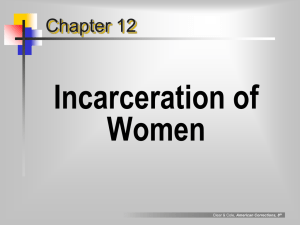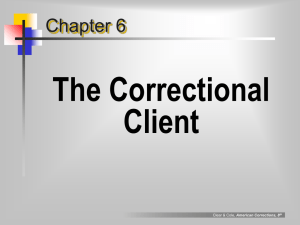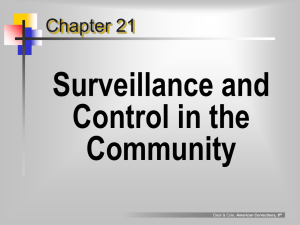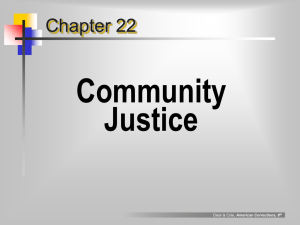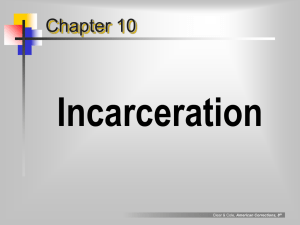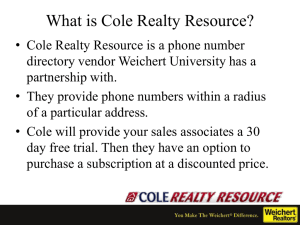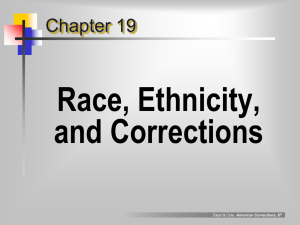Chapter 5
advertisement
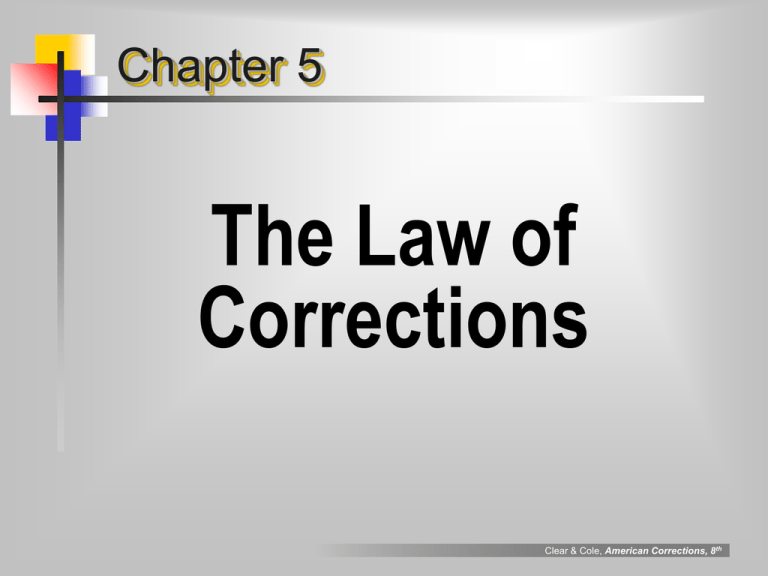
Chapter 5 The Law of Corrections Clear & Cole, American Corrections, 8th Foundations of Correctional Law Constitution fundamental law for federal government & for each state, containing a design for government & basic rights of individuals Statute laws passed by legislative authority e.g., California corrections: Title 15 legal rules produced by judicial decisions created by governmental agencies Goal: to implement details of agency and the law as it pertains to agency operations Case Law Regulations Clear & Cole, American Corrections, 8th Law and the U.S. Supreme Court The End of the Hand’s-off Policy a judicial policy of noninterference in the internal administration of prisons Access the increase in filings was assisted by Supreme Court decisions that eased prisoner access to the courts limitations were imposed on the grounds of institutional security, but prisoners need access to the courts to ensure that officials followed the law. The to the Courts Prisoners’ Rights Movement the NAACP’s Legal Defense and Education Fund and the National Prison Project of the American Civil Liberties Union became concerned about prisoners’ rights. Clear & Cole, American Corrections, 8th hands-off policy a judicial policy of noninterference in the internal administration of prisons Clear & Cole, American Corrections, 8th the end of “hands-off” Cooper v. Pate (US, 1964) prisoners in state & local institutions are entitled to protections of §1983 of the Civil Rights Act of 1871 (42 USC 1983), which imposes civil liability on anyone who denies another of the latter’s constitutional rights. “civil liability” responsibility for compensating another for the denial of the latter’s rights award for damages may be awarded to a plaintiff in a civil action §1983 = most common avenue for challenging jail & prison conditions Clear & Cole, American Corrections, 8th “precedent” legal rules created by judicial decisions, which serve to guide decisions of other judges in subsequent similar cases Clear & Cole, American Corrections, 8th “habeas corpus” a judicial order (called a “writ”) requesting that a person holding another person produce the prisoner and give reasons to justify continued confinement “you have the body” Clear & Cole, American Corrections, 8th legal doctrines controlling correctional rulings “least restrictive method” a principle which requires officials to select that administrative remedy for any problem so that the remedy constitutes the least possible threat to personal rights and represents the least invasive means of solving the problem Clear & Cole, American Corrections, 8th legal doctrines controlling correctional rulings “compelling state interest” a principle which requires the government to have a significant, legitimate, and persuasive (i.e., compelling”) reason for wanting to impose a regulation before it may create or impose a condition, rule, or procedure Clear & Cole, American Corrections, 8th legal doctrines controlling correctional rulings ... “clear and present danger” a principle which allows officials to infringe on rights arguably protected by the 1st Amendment, in cases when the threat to security or the safety of individuals is so obvious that it constitutes a “clear and present danger” that cannot be ignored Clear & Cole, American Corrections, 8th legal doctrines controlling correctional ruling “rational basis test” a principle which requires that a regulation constitute a reasonable and rational method of advancing a legitimate penological interest or institutional goal. Clear & Cole, American Corrections, 8th Constitutional Rights of Prisoners The First Amendment The Fourth Amendment The Eighth Amendment The Fourteenth Amendment A Change of Judicial Direction Impact of the Prisoners’ Rights Movement Clear & Cole, American Corrections, 8th 1st Amendment rights 1st Amendment speech Procunier v. Martinez, 1974 mail censorship permitted only for prison security Turner v. Safley, 1987 inmate-inmate mail can be prohibited; restriction must be related to legit. interests. Thornburgh v. Abbott, 1989 warden may reject incoming publications, based on security concerns religion Fulwood v. Clemmer, 1962 Muslim faith is legitimate state not required to provide clergy unconventional religions-Buddhism-ok Orthodox Jews right to religious diet scam religions not protected work may properly interfere with religious practices Gittlemacker v. Prasse, 1970 Cruz v. Beto, 1972 Kahane v. Carlson, 1975 Theriault v. Carlson, 1977 O’Lone v. Estate of Shabazz, 1987 Clear & Cole, American Corrections, 8th 4th Amendment rights protection against unreasonable searches and seizures Lanza v. New York, 1962 US v. Hitchcock, 1972 warrantless search of cell is not unreasonable; evidence is admissible Bell v. Wolfish, 1979 conversations recorded in a jail visitor’s room not protected by 4th Amendment strip searches, esp. after visits ok, when need for searches outweighs personal rights invaded Hudson v. Palmer, 1984 Officials may search cells without a warrant, seize materials Clear & Cole, American Corrections, 8th 8th Amendment rights protection against excessive bail & fines, and cruel & unusual punishment Ruiz v. Estelle, 1975 Texas prison system unconstitutional Deliberate indifference to serious medical needs = “unnecessary and wanton infliction of pain” Estelle v. Gamble, 1976 Rhodes v. Chapman, 1981 double-celling & crowding ≠ cruel & unusual. Standard = “wanton & unnecessary infliction of pain”; & condition must be “grossly disproportionate” to the severity of the crime Whitley v. Albers, 1986 shooting inmate in leg during riot ≠ C&U (if in good faith) prisoners must show that objectively C&U conditions exist due to “deliberate indifference of officials” Wilson v. Seiter, 1991 Clear & Cole, American Corrections, 8th 14th Amendment rights 14th Amendment due process no agent or instrumentality of government will use any procedures to arrest, prosecute, try, or punish any person, other than those procedures prescribed by law equal protection the law will be applied equally to all persons, without regard to individual characteristics as gender, race, and religion Clear & Cole, American Corrections, 8th “totality of conditions” the aggregate of circumstances in a correctional facility that, when considered as a whole, may violate the protections of the 8th Amendment, even though any single condition does not violate such guarantees Pugh v. Locke (Alabama, 1976) Clear & Cole, American Corrections, 8th 14th Amendment rights guarantee of due process & equal protection of the laws Wolff v. McDonnell, 1974 basic elements of due process must be present in prison disciplinary proceedings Baxter v. Palmigiano, 1976 no right to counsel in prison disciplinary proceedings Vitek v. Jones, 1980 involuntary transfer of prisoner to mental hospital requires hearing & minimal elements of due process like notice and counsel Sandin v. Conner, 1995 transfer to disciplinary segregation is not the type of atypical, significant deprivation that requires due process protections outlined in Wolff Clear & Cole, American Corrections, 8th “ombudsman” a public official who investigates complaints against government officials and recommends corrective measures Clear & Cole, American Corrections, 8th “mediation” vehicle for dispute resolution, in which the parties in conflict submit their differences to a third party for resolution, and whose decision (in the correctional setting) is binding on both parties Clear & Cole, American Corrections, 8th Morrissey v. Brewer, 1972 parole revocation process must include basic elements of due process (408 U.S 471) Clear & Cole, American Corrections, 8th Gagnon v. Scarpelli, 1973 probation revocation process must include basic elements of due process ( 411 U.S 778) Clear & Cole, American Corrections, 8th Greenholtz v. Inmates (Neb. Penal & Corr. Complex), 1979 there is no right to parole or to be conditionally release prior to expiration of sentence Clear & Cole, American Corrections, 8th Monell v. Dept. Social Services (NY city), 1979 individual officers AND the agency may be sued when a person’s civil rights are violated by the agency’s “customs and usages” (including poor training and supervision) Clear & Cole, American Corrections, 8th Booth v. Churner, 2001 prisoner seeking monetary damages must first complete prison administrative processes before filing lawsuit (00 U.S. 99-1964) Clear & Cole, American Corrections, 8th Prison Litigation Reform Act, 1966 restricted number of §1983 lawsuits # has dropped by nearly 50% since enactment, despite increase in prison population gives greater deference to prison administrators in operation of facilities prohibits filing of additional lawsuits if previous 3 were dismissed as frivolous Clear & Cole, American Corrections, 8th
